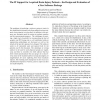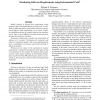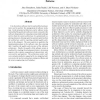KBSE
2002
IEEE
14 years 5 months ago
2002
IEEE
Inaccuracies, or deviations, in the measurements of monitored variables in a control system are facts of life that control software must accommodate—the software is expected to ...
IWPC
2002
IEEE
14 years 5 months ago
2002
IEEE
Studying how a software system has evolved over time is difficult, time consuming, and costly; existing techniques are often limited in their applicability, are hard to extend, a...
ISESE
2002
IEEE
14 years 5 months ago
2002
IEEE
Organisational problems in industry have evoked increased interest in empirical methodologies in the broader software engineering community. In particular, the human role in softw...
ICSM
2002
IEEE
14 years 5 months ago
2002
IEEE
Design patterns are widely recognized as important software development methods. Their use as software understanding tools, though generally acknowledged has been scarcely explore...
ICSM
2002
IEEE
14 years 5 months ago
2002
IEEE
Unregulated evolution of software often leads to software ageing which not only makes the product difficult to maintain but also breaks the consistency between design and impleme...
ICSM
2002
IEEE
14 years 5 months ago
2002
IEEE
Software is multidimensional but the tools that support it are not. The lack of tool support causes the software artifacts representing different dimensions to evolve independentl...
HICSS
2002
IEEE
14 years 5 months ago
2002
IEEE
The problems of producing a software system to assist in the rehabilitation of people who have suffered serious traumatic brain injuries are described. In addition to this primary...
HICSS
2002
IEEE
14 years 5 months ago
2002
IEEE
Ideally, software is derived from requirements whose properties have been established as good. However, it is difficult to define and analyze requirements. Moreover, derivation of...
CSMR
2002
IEEE
14 years 5 months ago
2002
IEEE
It is shown how software metrics and architectural patterns can be used for the management of software evolution. In the presented architecture-centric software evolutionmethod th...
CSMR
2002
IEEE
14 years 5 months ago
2002
IEEE
Maintaining software is very difficult, not only because of the number of software artifacts, but also because of the large variety of artifacts. Software includes programs, but a...



